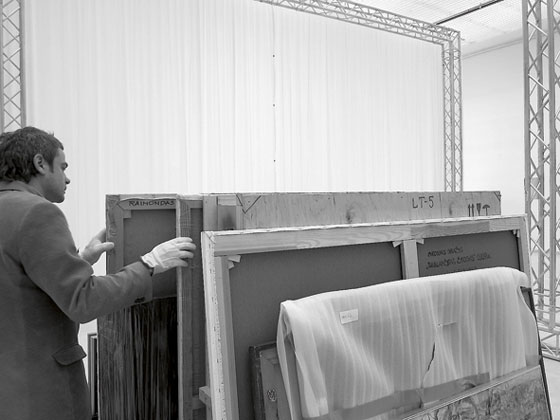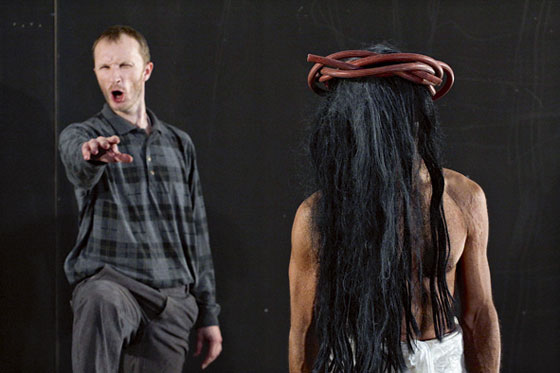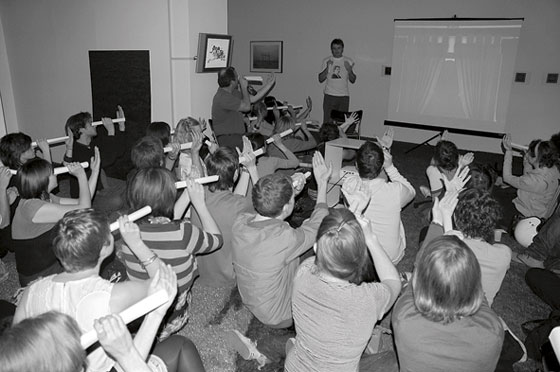|
|
| Darius Mikšys. Behind the White Curtain Virginija Januškevičiūtė. Curator | |
| – Would it be wrong to state that you perceive artistic action as a form of self-perfection? – Exactly, I do. Otherwise it’s not worth doing anything. – Is your conception of self-perfection purely egoistic, or – on the contrary – do you integrate yourself to an increasingly greater extent, and become more and more useful to the environment and society? – I have a benevolent attitude towards society, yet my aspirations are by no means related to the benefit of it, as that would be insolence. I would like society to be very dynamic and in a state of ongoing reform towards modernity and creativity. – Do you mean local or international society? – The local one. I am a patriot, and this society is the most important to me. – A patriot of Lithuania? – I advocate the idea of a national state. This is a huge problem for myself. (Darius Mikšys in conversation with Raimundas Malašauskas, ‘Is it Worth Realising an Idea’ // Šiaurės Atėnai, 21 October, 2000) | |
 Darius Mikšys. Behind the White Curtain. Lithuanian pavilion at the Biennale, rehearsal in Vilnius. 2011. Publicity photo | |
| According to Darius Mikšys, the idea of a self-constructed, self-organized art collection as a mirror of society has been haunting him for several years. The occasion to realize it occurred when he was writing a proposal for what was meant to become his first solo exhibition, the Lithuanian Pavilion at the 54th Venice Biennale. The occasion lent itself easily to the illusion of a self-organized event: if the pavilion is a governmental instrument for displaying national art, Mikšys’s project would consist of simply using it for this exact purpose. The artist proposed himself as an extension of the Lithuanian government’s policies and delegated the participation to several hundred other artists. Identification of the right tools for this purpose was assisted by public cultural policies. Darius Mikšys deduced that the committee(s) that award the individual state grants have, over the course of the last two decades (the whole period of Lithuania’s independence), formed a national collection of contemporary art by directly providing certain artists with the means for production. He decided to draw this work to a conclusion by establishing a mechanism for bringing this collection together and displaying it in Venice. All the recipients of a state grant for visual arts were contacted with a request to select one of their own artworks from the period of several months when they were receiving the stipend, to be briefly displayed on request from visitors to the Lithuanian Pavilion. When not in demand, the works will be stored behind a white curtain – hence the project’s title. Prior to the project’s public rehearsal at the Contemporary Art Centre in Vilnius (15 April –1 May, 2011), more than half of the recipients of the state grants had answered the call, forming a collection of 173 pieces. The white curtain sparked criticism even before it was installed: many found it offensive that the artworks may never appear on display. Others feared that Mikšys is merely manipulating the two hundred artists’ names as easily obtained symbolic capital and robbing these artists of a “real” opportunity to participate in the Biennale, or railed against the decision to cut the arbitrarily defined applied arts section out of the scheme. Redas Diržys, an artist and teacher who established the Alytus Biennial in 2005 and soon merged it with the Art Strike movement as per Stewart Home, publicly accused the project of aligning with consumerist ideology and proposed that everyone should destroy their work instead. (Diržys’s proposal, to my mind, lacks the twisted purposefulness of some of his earlier projects, the marginal biennial among them, and presents itself as a hollow anarchist slogan.) The word ‘fiasco’ appeared here and there. Indeed, the precision of the mechanism that Darius Mikšys set in motion remains in question, some of its loose parts already left behind or waiting for an improvised replacement. But above all, often clouded by the issues of logistics, responsibility and display, there is the most disturbing uncertainty: is this a prank? The opening lines of the project’s official description start off with a depiction of Lithuania’s first national exhibition in 1907, and an astounding question: what would such an exhibition look like if it were put together today? Can he seriously be trying to distil a body of work in which the (Lithuanian?) viewer “could recognize him- or herself, like in a mirror or the cinema screen”? And – will we ever know? | |
 Darius Mikšys. The Copy. Video still. 2010 | |
| * “How many debuts do you need to make sure you’re a complete failure?” – rhetorically asked Valentinas Klimašauskas, curator of the exhibition Enthusiasts in 2005, where Darius Mikšys was also a participant. It was his seventh or eight presentation at the Contemporary Art Centre in Vilnius. He had already shown a textual piece How to be Happy in an exhibition of the same title in 1999, also Limits of Imagination, a project based on his internet survey of visual representation of aliens in Parallel Progressions in 2000. In 2001 he showed Replica of ‘Cobra’ – a photograph of a replica of a sports car in Walls for NATO, and two videos in Self-Esteem: Focus on a Girl and video documentation of a visit to the Parapsychology Fair. A year later, he gathered together a temporary collection of hand-made music CD covers for the 8th Baltic Triennial of International Art. “Maybe this will be my best unrealized project ever”, Mikšys answered another curator, Raimundas Malašauskas, in 2000, while preparing for one of the above. Seconds before, he had admitted that none of his ideas had yet been fully realized and expressed a strong preference for constant variation over definite result or even adventure, which “may become boring”. Every published conversation between the two comes back to the topic of food, which may suggest one way to pin the practicality that Mikšys implies when claiming that his “only abstract problem is finding ways of seeking self-perfection.” But he seems to have more on his plate: “I don’t really like art alone – only when it’s inside, say, people, humus, or even other art” – he will write six or seven years later. Around the millennium, Darius Mikšys established a company called Technomama, aimed at providing ‘more space’ for his artistic practice. During the course of the next few years he gradually replaced the imperative of self-perfection with the rhetorics of longevity, but the notion of exploring ‘variations’ remained at the heart of the matter. (“Sometimes some things need some better version of you”, he wrote in one of his many text performances.) Learning new skills, such as playing harmonica or cricket, lead him to establish Lithuania’s first cricket club, the Abdul Aziz Holiday XI (2007–ongoing). Notably, he achieved those skills by exploiting artists’ residency programs, one of the ‘vehicles’ provided by the institutional art system that were increasingly replacing Technomama. His reputation as a classic ‘creator’, the ‘enlightened builder’ may be supported by one or two other projects, particularly a proposal to establish a museum of music in a grounded Qantas airplane formerly used by ABBA during tours (Qantas, 2008). There is a strong, even alarming taste of ‘mission’ in his attempts to produce a print of the UK deejay Gilles Petterson’s body similar to the Shroud of Turin (yet un-realized), and presumably also in one of his most recent projects – a group picture of all ‘warriors’ present in the online video game ‘Halo’ at the same time (A Piece of Peace, also in progress). But, as proved by his multiple ‘deaths’ in Halo, most often his productions not just deviate from the straightforward logic of productivity, but also dig under its roots: among his other recent public endeavours was a workshop on avoiding eye contact (London, 2007), procrastinating his own lecture on procrastination, and designing a lecture that is supposed to be a copy of a particular ice cone (both in Vilnius, 2009). | |
 Darius Mikšys. How to Simulate Eye Contact. Lecture. London. 2007 | |
| While he often seems to struggle with his own ideas, he has lately developed a penchant for realizing those of others. The motives and intentions behind each of the projects vary. At the X Baltic Triennial of International Art in 2009 he presented Persuasion of Paul, a sculptural piece formally similar to the site-specific piece Disappearance by Paul Ramirez Jonas, displayed in the same exhibition. Mikšys claimed to have copied the piece out of pure fascination. In the 2010 Manifesta 8 in Murcia, Spain, he presented a long video, made in an attempt to recreate Bouchra Ouizguen’s video performance Madame Plaza – which was also shown in Manifesta 8. This time he alluded to the notions of understanding by doing and reverse engineering. It is completely possible to see the Venice project in this light, except that here he does not continue on the work of an artist, but an institution or a society, to which he assigns the role of curator of an imaginary collection. Caught in a long series of exhibitions, Mikšys has elaborated several conceptual schemes in an attempt to deny his own identity, as if in search of the least obvious path. At the Lyon Biennial in 2007 he quoted particle physics and used an illusionist’s dematerialization kit to introduce a dog as a by-product of his own absence. At the Sydney Biennale in 2008 (and, later, in Performa ’09 in New York and Lithuanian Art 2000–2010: Ten Years at the CAC in Vilnius) he claimed to be an artwork of his parents, and proposed this model to other artists and their families. The most obvious in his projects may be easily read as ironic. But their inner contradictions – the obscure angles, insights and standards that cancel out each other, tear apart any logic and lead to most absurd situations – let their productions bounce in the least expected directions. Even when everything else fails, their ability and encouragement to transcend is always their strongest part. Mikšys’s extended invitation to the 54th Venice Biennale has paradoxically urged him to contribute one of his own past projects, because he is also a recipient of a state grant. He contributed a drawing made on a blank loan form during a conversation with the artist Žilvinas Kempinas at a party in Brooklyn, New York, in 2001. The drawing has only been shown once, almost a decade after it was made, in an exhibition in Poznan in 2010. It represents a scheme that consists of what the artist refers to as ‘dots’ (“the dots represent one or more human beings”) and ‘orbits’ (“the orbits represent just anything”). The drawing is accompanied by excerpts of the conversation that may well be the key to most of his reservations, contradictions and vanishing trajectories: “(…) If you are stuck in any kind of orbit, even artistic – you are not an artist any more. Being an artist means moving between orbits and being in various places at the same time, or during some period of time. Being stable in a so-called ‘artistic orbit’ means that you just stopped being an artist.” What about those orbits? “Art is rarely innovative, because if it were, it would be undetectable as art, and most likely it wouldn’t be detectable at all (and so it could not survive)” – he wrote in yet another unrealized proposal. “Unless it would be liked as such.” A self-proclaimed concept designer, he is sometimes called a practitioner of persuasion art. Which brings us back to the idea of him manipulating several hundred artists (correction: works) in a project that brings, according to the headline in one Lithuanian daily, “20 years of art in one artwork”. | |
| go back | |







